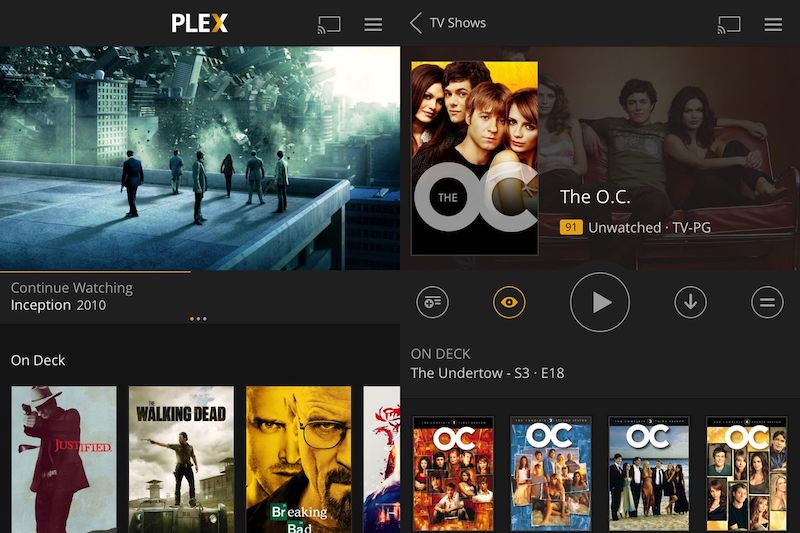Plex: Everything You Need to Know About the Geek Streaming Platform Flexing for Mainstream Attention
Plex has long been the preferred media management application for folks who know their computers. Now, it’s trying to become a streaming service for everyone

Plex has long been beloved by a certain class of geeky humans who acquire/rip/hoard vast gigabytes of digital media of all types. How geeky that crew can be is suggested by this how-to piece from January in, of course, PC Magazine that explains how to clean up the metadata and folder organization of your media using Plex’s tools.
Plex software long has enabled what Gizmodo, as one example, called “a kind of build-your-own Netflix,” though you could throw in Build Your Own Spotify, Apple Podcasts, home movies, photo apps, web services, and much else.
Plex calls its software “like mission control for your content.” Bring together a local network and a sufficiently vigorous hard drive or other host device, and you can share your trove of media easily throughout your household and beyond. That’s still part of the Plex promise, but now the company is trying to catch up with digital media’s newest trends, especially streaming video from the Internet.
Also Read: Plex Adds Live 80+ Streaming Channels
“Our goal is to be the one platform for all your media and we will be making progress toward that goal in 2020,” CEO Keith Valory said at the Consumer Electronics Show in January.
The Price for Plex
While Plex has long been well regarded for gracefully managing huge mounds of digital content, it’s come at a price that few consumers were willing to pay. After all, dealing with .mkv files and folder organization, never mind configuring your media server and hosting hardware, is about as far from a mainstream TV consumer’s expectations as imaginable.
Plex needed to catch up, or risk becoming a trivia question along the lines of “Whatever happened to Napster?” And so it is trying, at a furious clip.
NEXT TV NEWSLETTER
The smarter way to stay on top of the streaming and OTT industry. Sign up below.
Last December, the company launched its own ad-supported streaming service in more than 200 countries, a reflection of Plex’s significant international presence.
That free, ad-supported service initially featured about 1,000 movies on demand, including such familiar (and widetly licensed) titles as The Terminator, Ghost in the Shell and The Right Stuff. Studio providers included MGM, Warner Bros. TV, Lionsgate and Legendary. Plex promised ad loads around 50 to 60 percent as heavy as a typical broadcast show.
The free content sits on the same Plex sidebar as other content, including an integration with music service TIDAL, podcasts, web shows, streaming news and other content.
The base service brings a variety of capabilities, such as mobile downloads, support for 4K and most file types, VR co-watching, multiple user accounts, file sharing, and playlists.
The $4.99/month Plex Pass adds DVR capabilities, the ability to watch and record live TV (with your own digital antenna and tuner), parental controls, lyrics, trailers and more. The company said in December that it has about 15 million registered users, though a far smaller number subscribe to the Plex Pass.
“Two of the most important factors for an enjoyable streaming experience are easily being able to find something of interest to watch, and being able to watch it from any device you choose,” said CEO Valory. “Plex offers consumers across the globe a simple yet powerful platform for access to all types of content that can be streamed from all types of devices.”
Launching the free service immediately put Plex in competition with the Roku Channel, Tubi, Pluto, Xumo, and other free, ad-supported streamers. The competitor list has only grown since, with Peacock’s focus on its FAST tier, announced plans for a similar free tier at HBO Max, and the possibility that a beefed up “ViacomCBS All Access” might do the same.
More Capabilities
Since that launch, Plex has continued to roll out other capabilities, beginning with CES announcements that provided a vague but substantial development roadmap.
Among the functions that since have debuted is one small, Netflix-style change: skipping intros and catch-up material on episodic series. That’s a gift to power bingers and user experiences in general.
In April, the company launched Plexamp, an update of the long-time MP3 music software, Winamp, as well as a dedicated app for all those eager administrators of Plex servers. Plexamp works across five platforms, including iOS, Android and Linux. Both projects were only for Plex Pass subscribers, designed to appeal to power users. In that, they were basically preaching once again to the geek choir.
A few weeks later, the company launched Watch Together, for virtual watch parties. another increasingly popular function found on many major subscription services and third-party providers.
The biggest move so far came earlier this month, with the addition of 80 channels of linear TV programming to go with all those movies on Plex’s FAST service. Eight of the 80 channels came from Cinedigm, including ConTV, Docurama and the Bob Ross Channel. Crackle, with films from Sony and Paramount, joined Plex in May.
Executives told Protocol their take on live TV isn't a straight-up replacement for specific cable channels, but rather a “good-enough” experience for cord-cutters looking for cost-sensitive video alternatives in a lean-back experience.
"It becomes a dirt-cheap way to replace cable," said co-founder and Chief Product Officer Scott Olechowski. Ultimately, it’s not so much about replacing cable as providing a cable-flavored future that will eventually offer hundreds of tightly focused niche channels with linear, lean-back programming.
Olechowski said the viewing experience is slowly getting better too, as newer tech gets better at dropping in ad breaks. The company said ad loads are typically 50 percent to 60 percent of a traditional broadcast level.
Still on the plate for Plex additions are subscription video, a transactional VOD market for rental and purchase, and a way to use Plex to launch streaming content that Plex doesn’t host, like all those big streamers that have debuted recently.
The various add-ons move Plex toward its long-stated goal as a one-stop shop, if a geek-centric one, for all the possible digital-media needs a consumer might have. At the same time, Plex is jumping into new sectors with an imposing array of deep-pocketed incumbents.
As it does so, Plex does have one potential superpower: the ability to connect and recommend programming from across all of a consumer’s holdings, regardless of the media type or whether it’s coming from a pay service, free streaming outlets, or the user’s own library.
For instance, you could watch The Lion King, and get recommendations for the movie’s soundtrack from TIDAL, a podcast featuring director Jon Favreau, and a YouTube short about the voice talent. Should Plex’s recommendation capabilities and new features continue to build that kind of muscular cross-platform beast, and do it painlessly for consumers who aren’t electronics engineers, it truly will have something to flex about.
David Bloom of Words & Deeds Media is a Santa Monica, Calif.-based writer, podcaster, and consultant focused on the transformative collision of technology, media and entertainment. Bloom is a senior contributor to numerous publications, and producer/host of the Bloom in Tech podcast. He has taught digital media at USC School of Cinematic Arts, and guest lectures regularly at numerous other universities. Bloom formerly worked for Variety, Deadline, Red Herring, and the Los Angeles Daily News, among other publications; was VP of corporate communications at MGM; and was associate dean and chief communications officer at the USC Marshall School of Business. Bloom graduated with honors from the University of Missouri School of Journalism.

